F-4: Difference between revisions
Pbcjohnston (talk | contribs) Added photos |
Pbcjohnston (talk | contribs) Added new Header |
||
| (6 intermediate revisions by 2 users not shown) | |||
| Line 1: | Line 1: | ||
[[File:F- | [[File:New Header F-class.jpg]] | ||
[[File:F-4 build 1.jpg|left|500px]] | |||
<div style="text-align: justify;"><span style="color:#00008B">The Skate under construction at the Moran Company yards in Seattle, November 3, 1909. All of her framework has been riveted to the keel and some of the internal tankage has been assembled. | |||
[[File:F-4 | <small>Photo courtesy of Bill Lightfoot, author of ''Beneath the Surface.''</small> | ||
[[File:Red bar sub new.jpg]] | |||
[[File:F-4 build 2.jpg|left|500px]] | |||
A photo on the same day as the one above from a different vantage point shows Skate from the starboard side. All of the frames are internal to the pressure hull. The hull plating itself would be riveted to the frames in a later step. | |||
<small>Photo courtesy of Bill Lightfoot, author of ''Beneath the Surface.''</small> | |||
[[File:Red bar sub new.jpg]] | |||
[[File:F-4 build 3.jpg|left|500px]] | |||
Skate now seen on January 3, 1910 with most of the hull plating installed. The opening to the right of center is where the conning tower would be installed. | |||
<small>Photo courtesy of Bill Lightfoot, author of ''Beneath the Surface.''</small> | |||
[[File:Red bar sub new.jpg]] | |||
[[File:F-4 build 4.jpg|left|500px]] | |||
Skate seen from the stern on June 10, 1910 at the Moran Company shipyard in Seattle, WA. The propeller shaft tubes have been installed, along with the rudder support casting. Some of the hull plating has yet to be installed in this area. | |||
<small>Photo courtesy of Bill Lightfoot, author of ''Beneath the Surface.''</small> | |||
[[File:Red bar sub new.jpg]] | |||
[[File:F-4 incline test.jpg|left|500px]] | |||
On November 17, 1911, two months before she was launched, Skate was renamed F-4. She is shown here in March of 1913 undergoing a stability inclining experiment. She was not yet fully completed and the Moran Company was still putting in the finishing touches. The background is likely Elliot Bay off Seattle, WA. | |||
<small>Photo from the private family collection of Mitchell Noll.</small> | |||
[[File:Red bar sub new.jpg]] | |||
[[File:F-4 aground 1.jpg|left|500px]] | |||
F-4 ran aground on the south side of the West Point Light House, on March 13, 1913. Magnolia Bluff is in the background. She was still under the ownership of the Moran Company at the time and was undergoing trials. She was enroute to Port Townsend for trials at the time and the company's captain, Simeon Burke Smith, explained it as a misjudgment in steering that caused the grounding. A tug was called and the sub pulled free. It was determined there was no damage and they proceeded to Port Townsend. | |||
Captain Smith was a former Navy submarine officer who left the Navy in March of 1912 to take a position with Electric Boat Company as a trial officer. He travelled to shipyards building Electric Boat submarines to conduct their sea trials prior to Navy acceptance. | |||
<small>Photo from the private family collection of Mitchell Noll.</small> | |||
[[File:Red bar sub new.jpg]] | |||
[[File:F-4 aground 2.jpg|left|500px]] | |||
Photo printed in the Seattle Post Intelligencer Newspaper on March 14, 1913 showing the F-4 aground on West Point, just northwest of downtown Seattle. To the left in the photo you can see under the submarine's bow that her mushroom anchor has been dropped. A ladder has been brought out from the West Point lighthouse to allow the captain, Simeon Burke Smith, to climb down and call for a tug using the telephone from the lighthouse. She was subsequently pulled of the beach on the next high tide by the tug Pioneer from the Puget Sound Tug Boat Company. | |||
<small>Photo from the Seattle Post Intelligencer Archive.</small> | |||
[[File:Red bar sub new.jpg]] | |||
[[File:F-4 aground 3.jpg|left|500px]] | |||
This is another photo from the Seattle Post Intelligencer on March 14, 1913 with an article describing the incident. | |||
<small>Photo from the Seattle Post Intelligencer Archive.</small> | |||
[[File:Red bar sub new.jpg]] | |||
[[File:F-4 with torpedo boats.jpg|left|500px]] | |||
F-4 is shown with two surface torpedo boats at Port Townsend, WA., March or April of 1913 while she was undergoing trials. The two torpedo boats are the USS Davis (Torpedo Boat No. 12) and the Fox (Torpedo Boat No. 13). There is a local coastal steamer in the background. They plied the waters of Puget Sound for decades with cargo and passengers, becoming a fixture of local life. Some of them would remain in service into the 1940's. | |||
The USS Fox would have an interesting fate. Decommissioned in 1916, she was demilitarized and sold to a private firm. She was used as an oil storage barge for many years, moored at the end of Sheldon Street in Bremerton, WA. She eventually sank at her moorings and the land around her filled in to eventually become Evergreen Park. As far as can be determined, her hulk is still there to this day. | |||
<small>Photo from the private family collection of Mitchell Noll.</small> | |||
[[File:Red bar sub new.jpg]] | |||
[[File:F-4 diving.jpg|left|500px]] | |||
F-4 making a 200 foot dive in Seattle Harbor, (Elliott Bay). West Seattle can be seen in the background, circa April 1913 after returning from trials on Port Townsend Bay. | |||
The process was to make a shallow dive, like seen in this photo, achieve a neutral buoyancy and then drop the mushroom anchor housed under the bow to the bottom and slowly winch the submarine down to depth. Twenty-four hours later the sub returned to the surface. All through her trials the F-4 was plagued by numerous failures of mechanical systems but these were considered "normal and acceptable" for that time. The trials were designed for exactly that purpose, to find out what still needed to be worked on. The F-4 was commissioned May 3, 1913 in Seattle with Ensign Kirkwood Donovin Commanding, with the ill-fated ENS Alfred Ede as XO. He was to perish as the F-4's Commanding Officer with the rest of the crew two years later off Honolulu Harbor. | |||
<small>Photo from the private family collection of Mitchell Noll.</small> | |||
[[File:Red bar sub new.jpg]] | |||
[[File:F-4 george deeth.jpg|left|500px]] | |||
This photo of the USS F-4 was taken in San Pedro or maybe San Diego Harbor prior to flotilla's departure to Hawaii. | |||
The man at the top of the mast is Electricians Mate 2nd Class George L. Deeth. He may have just been goofing off but more likely he had been checking the light at the mast head. Maintenance of the running lights fell under the responsibility of an Electricians Mate. Proof of this identification comes from the Deeth family archives that show a very poor quality version of this same photo. Deeth would unfortunately perish along with his shipmates when the F-4 sank in 1915. | |||
<small>Photo from the private collection of Ric Hedman.</small> | |||
[[File:Red bar sub new.jpg]] | |||
[[File:F-4 with another F-boat.jpg|left|500px]] | |||
The USS F-4 and another F-class submarine dockside, Likely in Honolulu 1914-1915. The unidentified boat is probably the F-2 or F-3 since the F-1 had a large | |||
dome on her deck. Notice the spar bouys stacked on the dock. The back of the card reads; ''"Here is a picture of the Submarine F4 which sank in the harbor here, with 21 men on board. I suppose you read about it in the papers. The Maryland is here now getting it up."'' | |||
<small>Photo from the private collection of Ric Hedman.</small> | |||
[[File:Red bar sub new.jpg]] | |||
[[File:F-4 crew four.jpg|left|500px]] | |||
Four members of the F-4 crew going on "...shore leave...". Newspaper photo posted in the Denver Post on March 29, 1915. | |||
This photo tells us a bit about the possible relationships aboard the submarine, who the different men associated with. It was a small crew but men still made choices of who they hung out with. The newspaper may have just asked the 4 to stand together for the photo but it is also possible they were a group heading out together. | |||
The man on the left is thought to be Albert F. Jennie, Electricians Mate 2nd Class of Festus, MO. Chief Electricians Mate Harley Colwell from Seattle, WA is next in his uniform. Based on the single hash-mark on his left sleeve he had less than 8 years in the Navy at the time of this photo. The third man is believed to be Horace L. Moore, Gunner's Mate 1st Class of Philadelphia, PA. The man on the right is Clark George Buck Gunners Mate 2nd Class from Tacoma, WA. | |||
So, in 1915 is this is the way submarine sailors "Hit the Beach" for Liberty? They are looking pretty dashing in the suits, ties and straw hats! | |||
<small>Photo from the family collection of George Myers, who is a distant cousin of Clark Buck.</small> | |||
[[File:Red bar sub new.jpg]] | |||
[[File:f-4 backing-Colorized.jpg|left|500px]] | |||
<div style="text-align: justify;"><span style="color:#00008B"> | <div style="text-align: justify;"><span style="color:#00008B"> | ||
The USS F-4 backing away from her slip in Honolulu Harbor in this colorized version of this photo. The date is unknown but this is pretty much as she would have looked on the morning of March 25, 1915 when she left for her last dive taking all of her crew aboard to their deaths. Since the submarine is backing this means she is operating on battery power alone since the propellers were direct drive from the engines in one direction only, ahead. | |||
The Quarantine Dock is seen in the background with a ship and a barge. This is believed to be the Interred German Cruiser SMS Geier. The barges are probably delivering coal to the Geier. Several other vessels are anchored to the left of the Quarantine dock. | |||
On top of the conning tower the helmsman's station seen to the left of the forward periscope. It is unmanned so steering must be being handled from the Control Room inside the submarine. The man at the bow has a large deck wrench. Probably used to secure deck hatches. The man forward of the conning tower is probably checking that all is secure. A larger group of men gather on the aft deck in preparation to dropping below through the engine room hatch. | |||
It was common practice with these submarines to actually submerge in the harbor and travel out the channel with just the periscopes showing. Periscope depth is reported to have been fifteen feet. This is how the F-4 was last seen by the F-2 before she went to the bottom with all hands. | |||
<small>Image courtesy of the Maritime Museum of San Diego</small> | <small>Image courtesy of the Maritime Museum of San Diego</small> | ||
Latest revision as of 03:15, 14 March 2025

Photo courtesy of Bill Lightfoot, author of Beneath the Surface.
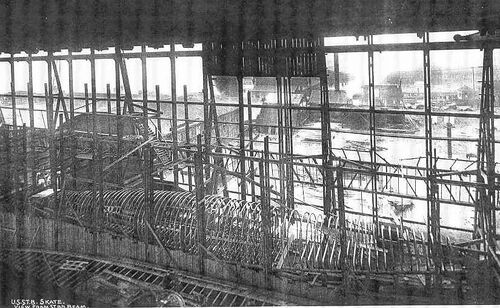
A photo on the same day as the one above from a different vantage point shows Skate from the starboard side. All of the frames are internal to the pressure hull. The hull plating itself would be riveted to the frames in a later step.
Photo courtesy of Bill Lightfoot, author of Beneath the Surface.
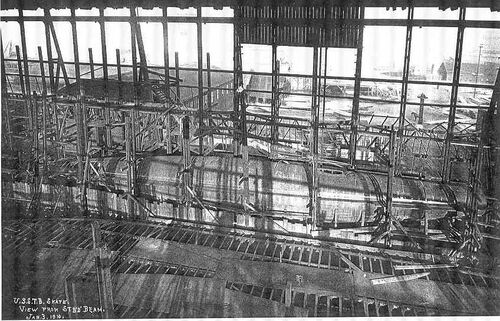
Skate now seen on January 3, 1910 with most of the hull plating installed. The opening to the right of center is where the conning tower would be installed.
Photo courtesy of Bill Lightfoot, author of Beneath the Surface.

Skate seen from the stern on June 10, 1910 at the Moran Company shipyard in Seattle, WA. The propeller shaft tubes have been installed, along with the rudder support casting. Some of the hull plating has yet to be installed in this area.
Photo courtesy of Bill Lightfoot, author of Beneath the Surface.
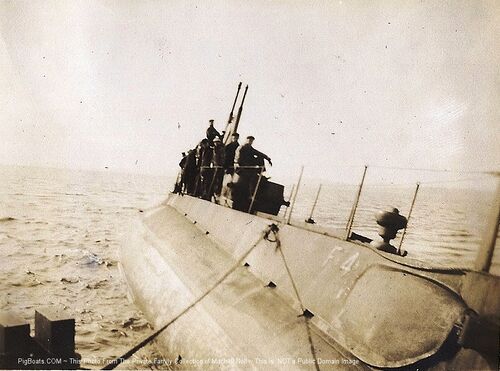
On November 17, 1911, two months before she was launched, Skate was renamed F-4. She is shown here in March of 1913 undergoing a stability inclining experiment. She was not yet fully completed and the Moran Company was still putting in the finishing touches. The background is likely Elliot Bay off Seattle, WA.
Photo from the private family collection of Mitchell Noll.
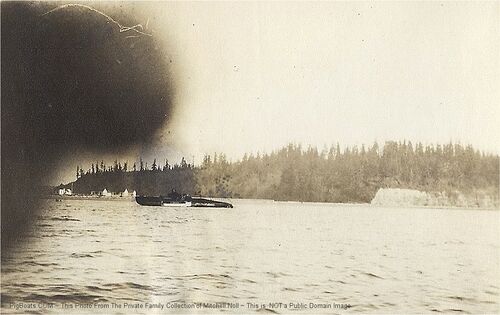
F-4 ran aground on the south side of the West Point Light House, on March 13, 1913. Magnolia Bluff is in the background. She was still under the ownership of the Moran Company at the time and was undergoing trials. She was enroute to Port Townsend for trials at the time and the company's captain, Simeon Burke Smith, explained it as a misjudgment in steering that caused the grounding. A tug was called and the sub pulled free. It was determined there was no damage and they proceeded to Port Townsend.
Captain Smith was a former Navy submarine officer who left the Navy in March of 1912 to take a position with Electric Boat Company as a trial officer. He travelled to shipyards building Electric Boat submarines to conduct their sea trials prior to Navy acceptance.
Photo from the private family collection of Mitchell Noll.
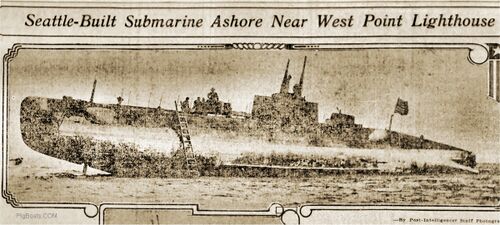
Photo printed in the Seattle Post Intelligencer Newspaper on March 14, 1913 showing the F-4 aground on West Point, just northwest of downtown Seattle. To the left in the photo you can see under the submarine's bow that her mushroom anchor has been dropped. A ladder has been brought out from the West Point lighthouse to allow the captain, Simeon Burke Smith, to climb down and call for a tug using the telephone from the lighthouse. She was subsequently pulled of the beach on the next high tide by the tug Pioneer from the Puget Sound Tug Boat Company.
Photo from the Seattle Post Intelligencer Archive.
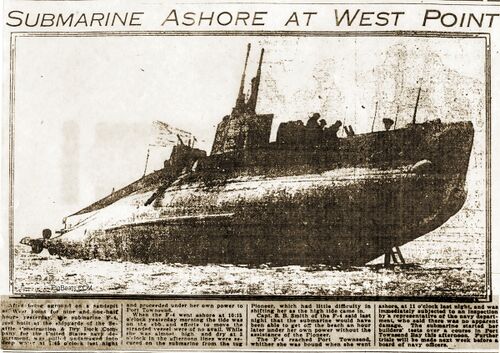
This is another photo from the Seattle Post Intelligencer on March 14, 1913 with an article describing the incident.
Photo from the Seattle Post Intelligencer Archive.

F-4 is shown with two surface torpedo boats at Port Townsend, WA., March or April of 1913 while she was undergoing trials. The two torpedo boats are the USS Davis (Torpedo Boat No. 12) and the Fox (Torpedo Boat No. 13). There is a local coastal steamer in the background. They plied the waters of Puget Sound for decades with cargo and passengers, becoming a fixture of local life. Some of them would remain in service into the 1940's.
The USS Fox would have an interesting fate. Decommissioned in 1916, she was demilitarized and sold to a private firm. She was used as an oil storage barge for many years, moored at the end of Sheldon Street in Bremerton, WA. She eventually sank at her moorings and the land around her filled in to eventually become Evergreen Park. As far as can be determined, her hulk is still there to this day.
Photo from the private family collection of Mitchell Noll.
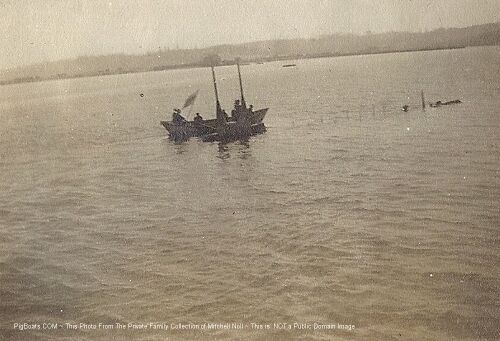
F-4 making a 200 foot dive in Seattle Harbor, (Elliott Bay). West Seattle can be seen in the background, circa April 1913 after returning from trials on Port Townsend Bay.
The process was to make a shallow dive, like seen in this photo, achieve a neutral buoyancy and then drop the mushroom anchor housed under the bow to the bottom and slowly winch the submarine down to depth. Twenty-four hours later the sub returned to the surface. All through her trials the F-4 was plagued by numerous failures of mechanical systems but these were considered "normal and acceptable" for that time. The trials were designed for exactly that purpose, to find out what still needed to be worked on. The F-4 was commissioned May 3, 1913 in Seattle with Ensign Kirkwood Donovin Commanding, with the ill-fated ENS Alfred Ede as XO. He was to perish as the F-4's Commanding Officer with the rest of the crew two years later off Honolulu Harbor.
Photo from the private family collection of Mitchell Noll.
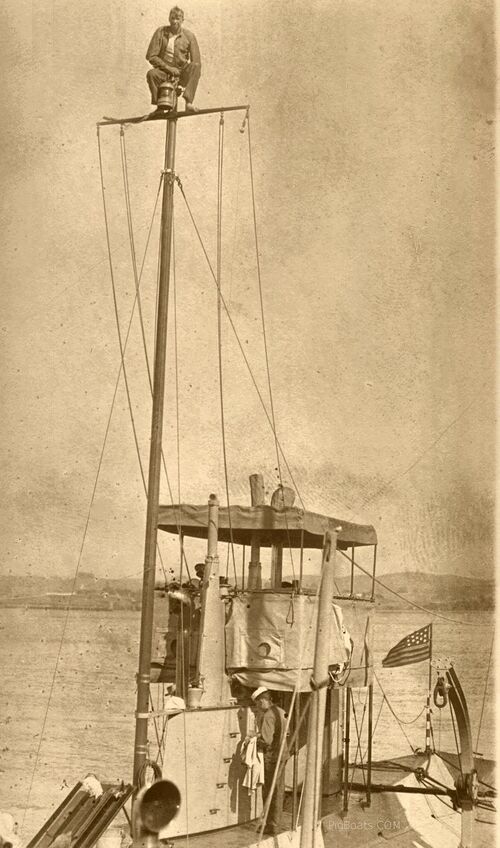
This photo of the USS F-4 was taken in San Pedro or maybe San Diego Harbor prior to flotilla's departure to Hawaii.
The man at the top of the mast is Electricians Mate 2nd Class George L. Deeth. He may have just been goofing off but more likely he had been checking the light at the mast head. Maintenance of the running lights fell under the responsibility of an Electricians Mate. Proof of this identification comes from the Deeth family archives that show a very poor quality version of this same photo. Deeth would unfortunately perish along with his shipmates when the F-4 sank in 1915.
Photo from the private collection of Ric Hedman.
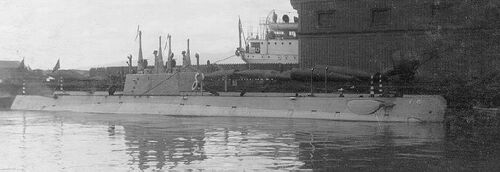
The USS F-4 and another F-class submarine dockside, Likely in Honolulu 1914-1915. The unidentified boat is probably the F-2 or F-3 since the F-1 had a large dome on her deck. Notice the spar bouys stacked on the dock. The back of the card reads; "Here is a picture of the Submarine F4 which sank in the harbor here, with 21 men on board. I suppose you read about it in the papers. The Maryland is here now getting it up."
Photo from the private collection of Ric Hedman.
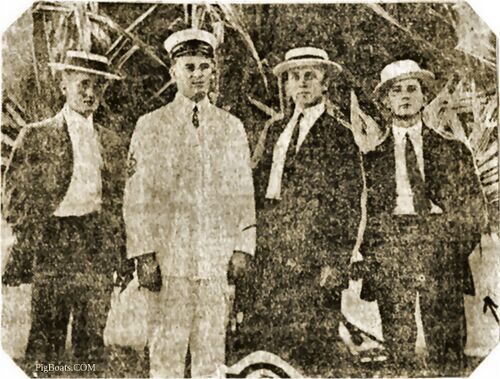
Four members of the F-4 crew going on "...shore leave...". Newspaper photo posted in the Denver Post on March 29, 1915.
This photo tells us a bit about the possible relationships aboard the submarine, who the different men associated with. It was a small crew but men still made choices of who they hung out with. The newspaper may have just asked the 4 to stand together for the photo but it is also possible they were a group heading out together.
The man on the left is thought to be Albert F. Jennie, Electricians Mate 2nd Class of Festus, MO. Chief Electricians Mate Harley Colwell from Seattle, WA is next in his uniform. Based on the single hash-mark on his left sleeve he had less than 8 years in the Navy at the time of this photo. The third man is believed to be Horace L. Moore, Gunner's Mate 1st Class of Philadelphia, PA. The man on the right is Clark George Buck Gunners Mate 2nd Class from Tacoma, WA.
So, in 1915 is this is the way submarine sailors "Hit the Beach" for Liberty? They are looking pretty dashing in the suits, ties and straw hats!
Photo from the family collection of George Myers, who is a distant cousin of Clark Buck.
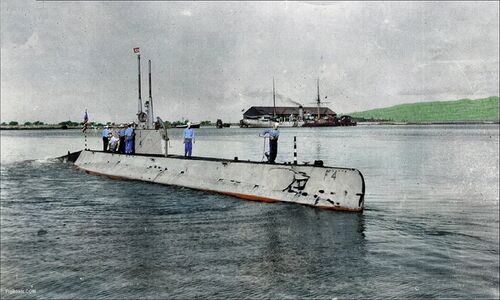
The USS F-4 backing away from her slip in Honolulu Harbor in this colorized version of this photo. The date is unknown but this is pretty much as she would have looked on the morning of March 25, 1915 when she left for her last dive taking all of her crew aboard to their deaths. Since the submarine is backing this means she is operating on battery power alone since the propellers were direct drive from the engines in one direction only, ahead.
The Quarantine Dock is seen in the background with a ship and a barge. This is believed to be the Interred German Cruiser SMS Geier. The barges are probably delivering coal to the Geier. Several other vessels are anchored to the left of the Quarantine dock.
On top of the conning tower the helmsman's station seen to the left of the forward periscope. It is unmanned so steering must be being handled from the Control Room inside the submarine. The man at the bow has a large deck wrench. Probably used to secure deck hatches. The man forward of the conning tower is probably checking that all is secure. A larger group of men gather on the aft deck in preparation to dropping below through the engine room hatch.
It was common practice with these submarines to actually submerge in the harbor and travel out the channel with just the periscopes showing. Periscope depth is reported to have been fifteen feet. This is how the F-4 was last seen by the F-2 before she went to the bottom with all hands.
Image courtesy of the Maritime Museum of San Diego
Page created by:
Ric Hedman & David Johnston
1999 - 2023 - PigBoats.COM©
Mountlake Terrace, WA, Norfolk, VA
webmaster at pigboats dot com
